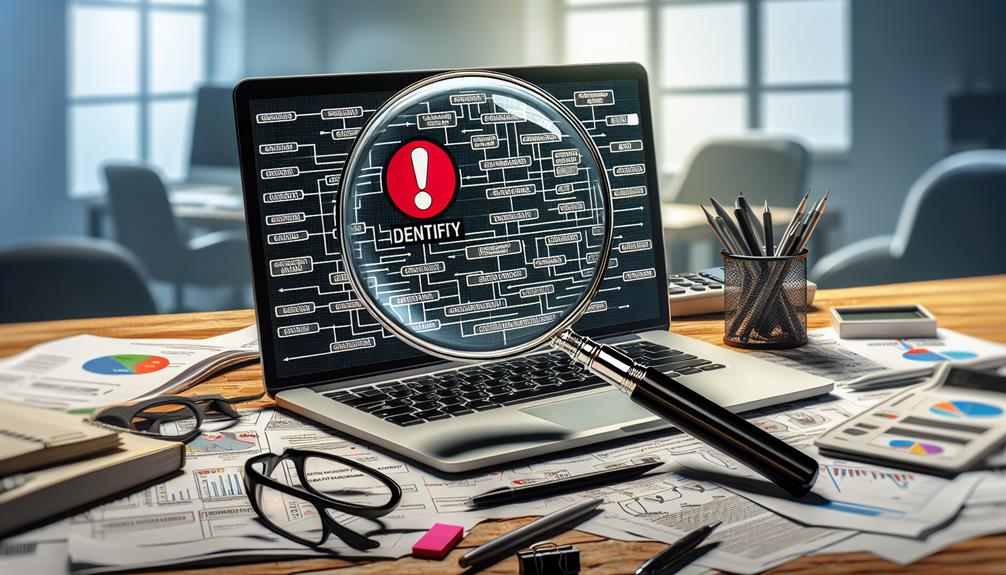You may be thinking that risk management strategies are only necessary for larger businesses with more resources. However, even small businesses are exposed to various risks that can have a significant impact on their operations. In order to ensure the success and longevity of your small business, it is essential to implement effective risk management strategies. These strategies not only help you identify and assess potential risks, but also provide you with the necessary tools to mitigate and monitor them. By integrating these nine best risk management strategies into your business practices, you can safeguard your small business and navigate uncertain times with confidence.
Identifying Risks

To effectively manage risks, small businesses must first identify potential threats to their operations. This step is crucial as it allows you to proactively address and mitigate the risks that could potentially harm your business. By identifying these risks, you can develop strategies to reduce their impact and prevent any potential damage.
Start by conducting a thorough assessment of your business operations. Examine each aspect, from financial management to supply chain logistics, and identify any vulnerabilities or weaknesses that could pose a risk. This could include internal factors such as employee misconduct or external factors like changes in market conditions.
Additionally, stay informed about industry trends and regulatory changes that could affect your business. By keeping a close eye on these developments, you can anticipate potential risks and adjust your strategies accordingly.
Don't forget to involve your employees in the risk identification process. They often have valuable insights and can provide a different perspective on potential risks that you may have overlooked.
Once you have identified the risks, categorize them based on their severity and likelihood of occurrence. This will help you prioritize your risk management efforts and allocate resources effectively.
Assessing Risk Exposure
Assess your business's risk exposure by evaluating the potential impact and likelihood of occurrence for each identified risk. This step is crucial in developing effective risk management strategies for your small business. By assessing risk exposure, you can prioritize and allocate resources to mitigate the most significant risks.
To begin the assessment process, identify and categorize the potential risks your business could face. Consider both internal and external factors that may affect your operations, such as financial risks, market risks, legal risks, and operational risks. Once you have a comprehensive list of risks, evaluate the potential impact of each risk on your business. This involves analyzing the potential consequences in terms of financial loss, reputation damage, operational disruptions, and customer dissatisfaction.
Next, assess the likelihood of each risk occurring. Consider historical data, industry trends, and expert opinions to determine the probability of each risk materializing. This step will help you prioritize your risk management efforts and allocate appropriate resources to address the most probable risks.
Establishing Risk Appetite

Determine your small business's desired level of risk tolerance by establishing a clear risk appetite statement. This statement will outline the amount of risk your business is willing to accept in pursuit of its goals and objectives. It is crucial to define your risk appetite as it will guide your decision-making process when dealing with potential risks.
To establish your risk appetite, you need to assess various factors such as your business's financial position, industry regulations, and market conditions. Consider the potential impact of risks on your business's profitability, reputation, and operations. Determine the level of risk you are comfortable with and the boundaries within which you are willing to operate.
When defining your risk appetite, be specific and measurable. Use quantitative measures like percentages or monetary values to clearly articulate the level of risk you are willing to accept. Consider factors such as revenue targets, growth objectives, and debt ratios to develop a comprehensive risk appetite statement.
Once you have established your risk appetite, communicate it throughout your organization. Ensure that all employees understand the acceptable level of risk and align their actions accordingly. Regularly review and update your risk appetite statement to reflect changes in your business environment.
Implementing Risk Controls
Now that you have established your risk appetite, it's time to put in place the necessary risk controls for your small business. Implementing risk controls is crucial to minimize the impact of potential risks and protect your business from unforeseen events.
The first step in implementing risk controls is identifying the specific risks your business faces. Conduct a thorough assessment of your operations, processes, and external factors that could pose a risk to your business. This will help you prioritize the risks and determine the appropriate controls to mitigate them.
Once you have identified the risks, you can then develop and implement risk control measures. These measures can include implementing security protocols, creating backup systems, implementing regular maintenance and inspections, and providing training to employees on risk management procedures. It's important to tailor the controls to your business's specific needs and ensure they align with your risk appetite.
Regular monitoring and review of the implemented controls is essential. This will help you identify any gaps or weaknesses in the controls and make necessary adjustments to enhance their effectiveness. Additionally, staying updated on industry best practices and regulatory requirements will ensure your risk controls remain relevant and compliant.
Monitoring and Reporting Risks

To effectively manage risks in your small business, it is crucial to establish a system for monitoring and reporting potential risks. This will allow you to stay on top of any emerging threats and take timely action to mitigate them. Monitoring involves regularly assessing your business operations, identifying potential risks, and evaluating their likelihood and impact. By doing so, you can proactively address these risks before they escalate into major issues.
One effective way to monitor risks is to set up regular meetings or check-ins with your team. Encourage open communication and create a safe space for employees to voice their concerns and report any potential risks they have identified. This can help you gain valuable insights and different perspectives, enabling you to make informed decisions.
In addition to regular check-ins, implementing a reporting system is essential. This can include incident reporting forms, risk registers, or online reporting tools. Encourage employees to report any incidents or risks they encounter, even if they seem minor. By collecting this information, you can identify patterns and trends, allowing you to take proactive measures to prevent future occurrences.
Developing a Business Continuity Plan
Establish a comprehensive business continuity plan to ensure the resilience and continued operations of your small business in the face of unforeseen disruptions. A business continuity plan is a proactive approach to managing risks and ensuring business survival during times of crisis. It involves identifying potential threats, assessing their potential impact, and developing strategies to mitigate those risks.
To start developing your business continuity plan, begin by conducting a thorough risk assessment. Identify the key risks that could disrupt your business, such as natural disasters, cyber-attacks, or supply chain disruptions. Once you have identified these risks, determine their potential impact on your operations and prioritize them based on severity. This will help you allocate resources and prioritize your risk management efforts.
Next, develop strategies to mitigate these risks. This may include implementing redundant systems, establishing backup plans, or creating alternative supply chains. It is important to involve key stakeholders in this process, such as employees, suppliers, and customers, as they may have valuable insights and suggestions.
Regularly review and update your business continuity plan to ensure its effectiveness. Test your plan through simulations and drills to identify any gaps or weaknesses that need to be addressed. By regularly reviewing and updating your plan, you can adapt to changing circumstances and improve your overall resilience.
Conducting Regular Risk Assessments

Why is conducting regular risk assessments crucial for small businesses? Regular risk assessments are essential for small businesses because they help identify potential risks and vulnerabilities that could impact the business's operations and bottom line. By conducting these assessments on a regular basis, you can stay proactive in managing and mitigating risks, ensuring the long-term success of your business.
Regular risk assessments allow you to identify and prioritize potential risks, such as financial risks, legal risks, operational risks, or external risks like natural disasters or cybersecurity threats. By understanding these risks, you can develop strategies and implement measures to minimize their impact on your business. This proactive approach helps you avoid costly disruptions, financial losses, or reputational damage.
Furthermore, conducting regular risk assessments enables you to evaluate the effectiveness of your current risk management strategies and make necessary adjustments. As your business evolves and grows, new risks may emerge, and existing risks may change in nature or severity. By regularly assessing risks, you can ensure that your risk management strategies are up to date and aligned with your business goals.
Training and Educating Employees
Conducting regular risk assessments is crucial for small businesses to identify potential risks and vulnerabilities; however, an equally important aspect of risk management is training and educating employees. Your employees are the front line of defense against risks and vulnerabilities that can impact your business. By providing them with the necessary training and education, you can empower them to make informed decisions and take appropriate actions to mitigate risks.
Start by assessing the specific training needs of your employees. Identify the areas where they may lack knowledge or skills related to risk management. This could include areas such as cybersecurity, workplace safety, or compliance with regulations. Once you have identified the training needs, develop a comprehensive training program that addresses these areas.
It is important to ensure that the training is not a one-time event but an ongoing process. Regularly update and refresh the training materials to keep your employees up to date with the latest risks and best practices. Consider using a combination of in-person training sessions, online courses, and informative materials such as posters or newsletters to deliver the training.
Additionally, make sure to provide resources and support for employees to ask questions and seek clarification on risk management practices. Encourage an open and transparent culture where employees feel comfortable reporting potential risks and incidents.
Reviewing and Updating Risk Management Strategies

To effectively manage risks, it is essential for small businesses to regularly review and update their risk management strategies. As the business landscape evolves and new risks emerge, it is crucial to ensure that your risk management strategies remain effective and relevant. By regularly reviewing and updating your strategies, you can identify any gaps or weaknesses and make necessary adjustments to mitigate potential risks.
One important aspect of reviewing and updating risk management strategies is conducting a thorough risk assessment. This involves identifying and analyzing the various risks that your business may face, such as financial, operational, and reputational risks. By understanding the specific risks that are relevant to your business, you can develop targeted strategies to address them.
Additionally, it is important to regularly review and update your risk management policies and procedures. This includes evaluating the effectiveness of existing controls and making any necessary improvements. It is also important to stay informed about industry best practices and regulatory requirements, as these may change over time. By staying up to date with the latest developments, you can ensure that your risk management strategies align with current standards and expectations.

